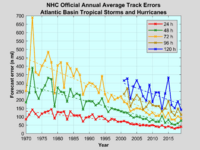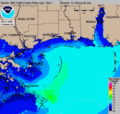Tropical cyclone forecast model facts for kids

A tropical cyclone forecast model is like a super-smart computer program. It uses lots of weather information to guess where a tropical cyclone (like a hurricane or typhoon) will go and how strong it will get. These models run on powerful supercomputers and use complex math. There are two main kinds of models: statistical and dynamic. They help us predict two important things: the storm's path (track) and its strength (intensity).
Contents
What Are Tropical Cyclone Forecast Models?
Tropical cyclone forecast models are special computer programs. They help scientists predict the future of big storms. Think of them as very advanced weather apps. They take in huge amounts of data. This data includes things like air temperature, wind speed, and humidity.
How Do These Models Work?
These models use powerful computers called supercomputers. They run complex mathematical equations. These equations help them understand how the atmosphere works. By solving these equations, the models can predict how a storm will move. They can also guess if it will get stronger or weaker.
Why Do We Need Forecast Models?
Predicting where a hurricane will go is super important. It helps people in its path get ready. They can evacuate if needed. It also helps emergency services plan. Accurate forecasts save lives and protect property.
Types of Forecast Models
There are two main types of tropical cyclone forecast models. Each type works a bit differently.
Statistical Models
Statistical models are like looking at history. They use past storm data to make predictions. For example, if many similar storms in the past moved a certain way, the model might guess this storm will too. They are good for quick predictions. They don't need as much computer power.
Dynamic Models
Dynamic models are more like building a mini-atmosphere. They use the actual laws of physics. They create a 3D picture of the atmosphere. Then, they simulate how the storm will interact with it. These models are very complex. They need supercomputers to run. They can give more detailed forecasts.
Hybrid Models
Sometimes, scientists combine both types. These are called hybrid models. They try to get the best of both worlds. They use the speed of statistical models. They also use the detail of dynamic models.
What Do Models Predict?
Tropical cyclone models focus on two main things. These are the storm's track and its intensity.
Predicting the Storm's Path (Track)
The track forecast tells us where the center of the storm is expected to go. This is often shown as a cone on a map. The cone shows the likely path of the storm's center. It's important to remember the storm is bigger than just its center. Strong winds and rain can be far from the center.
How Accurate Are Track Forecasts?
Over the years, track forecasts have gotten much better. Scientists keep improving the models. This means we can predict where a storm will go with more confidence. However, storms can still surprise us.
Predicting the Storm's Strength (Intensity)
Intensity forecasts predict how strong the storm will be. This includes its wind speed and how low its pressure is. A stronger storm means more damage. It also means more danger.
Challenges in Intensity Forecasting
Predicting intensity is harder than predicting track. Many things can make a storm stronger or weaker. These include ocean temperature and wind shear. Wind shear is when winds blow at different speeds or directions at different heights. This can tear a storm apart.
The Future of Forecasting
Scientists are always working to make models better. They are using new technologies. They are also using more data. This includes data from satellites and special aircraft. The goal is to make forecasts even more accurate. This will help keep everyone safer.
Images for kids
-
Significant track errors still occur on occasion, as seen in this Ernesto (2006) early forecast. The NHC official forecast is light blue, while the storm's actual track is the white line over Florida.
-
r-CLIPER for Hurricane Isabel (2003)
-
A NOAA prediction for Hurricane Irene






